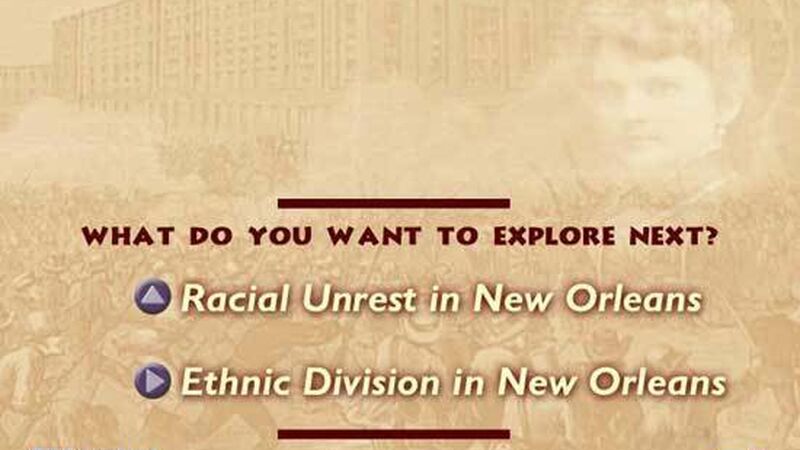Racial Unrest & Ethnic Division: Racial Unrest in New Orleans

Racial Unrest in New Orleans
Transcript
NARRATOR: While Kate Chopin was content to spend her time observing life in New Orleans, her husband was involved in politics. Many citizens of Louisiana felt threatened by the new power of republicans---mostly blacks and whites from the North after the Civil War. So they founded an organization called the Crescent City White League.
The group was led by blue bloods who were members of the most elite social organization in New Orleans, the Boston Club. Oscar was a member of the group, and in 1874 his company staged the battle of Canal Street and occupied the state house. They also overthrew the reconstruction governor�and believed they had destroyed reconstruction rule.
SOUNDBITE: Charles Vincent/Southern University
The governor and other elected officials were not permitted to conduct the state's business and in other areas of the state, elected officials were forced to resign or at least frightened out of their positions of responsibility and indeed some of them out of the state. A number of blacks were actually lynched.
NARRATOR: Federal troops arrived in New Orleans within a few weeks and restored the reconstruction government. However, a lot of damage had already been done. Thousands of African-Americans had been prevented from voting. And, hundreds had been forced to vote for people they opposed. As a teenager, Kate also had shown fervor for politics.
SOUNDBITE: David Chopin/Kate's Grandson
The story goes that during the Civil War the sympathies were for the South and she went out one time and tore down an American flag that was on the porch. I don't know if she was going to replace it with a Confederate flag or not. But, she got into a lot of hot water because of that. She was that kind person.
Racial Unrest & Ethnic Division: Ethnic Division in New Orleans

Ethnic Division in New Orleans
Transcript
NARRATOR: It's been said that Kate Chopin loved anything French. New Orleans was really a French city that had been occupied by the United States with the Louisiana purchase. Chopin witnessed many of the French ways of life disappear as the city became more Americanized. Canal Street served as the divide between the Creoles and "the American invaders." The Creoles settled downtown or below Canal Street in the colorful French quarter or Vieux Carrie. The Americans moved uptown above Canal Street. But, they all lived in close proximity to each other. And, Chopin got to observe both.
SOUNDBITE: Arnold Hirsch/University of New Orleans
There was a cultural mix across ethnic lines, across racial lines. However, right her social circle might be, there was a physical intimacy that was there. The social worlds did overlap.
NARRATOR: The worlds overlapped largely because a lot was done outside, especially during the summer months.
SOUNDBITE: Arnold Hirsch/University of New Orleans
They would have visited the open air markets which would have been scattered through the city. It was there that they would have found the mixture of peoples, heard the different languages, enjoyed he sights and sounds of what was still a very diverse city, perhaps the most unusual city in the United States.
NARRATOR: While Chopin had her French pride, scholars say the Americans were the ones who were growing in prosperity in New Orleans.
SOUNDBITE: Emily Toth/Louisiana State University
The French were losing their money, they may have had social status, but, they were, ah, as far as money goes, they were really on the way down, the Americans were on the way up.

